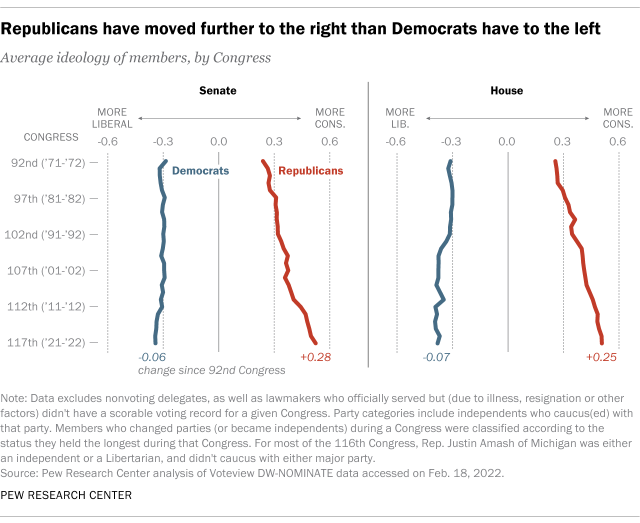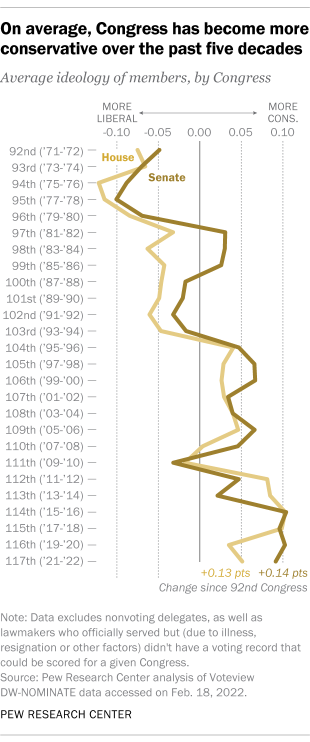What Caused the Democrats to Shift So Far Left?
It'southward become commonplace among observers of U.Southward. politics to decry partisan polarization in Congress. Indeed, a Pew Enquiry Center analysis finds that, on average, Democrats and Republicans are farther apart ideologically today than at whatsoever time in the by 50 years.

Merely the dynamics backside today'south congressional polarization accept been long in the making. The analysis of members' ideological scores finds that the current standoff between Democrats and Republicans is the result of several overlapping trends that accept been playing themselves out – and sometimes reinforcing each other – for decades.
- Both parties have grown more ideologically cohesive. There are now simply about two dozen moderate Democrats and Republicans left on Capitol Hill, versus more than 160 in 1971-72.
- Both parties have moved further away from the ideological middle since the early on 1970s. Democrats on boilerplate have get somewhat more liberal, while Republicans on average accept become much more than conservative.
- The geographic and demographic makeup of both congressional parties has changed dramatically. Nearly one-half of House Republicans now come from Southern states, while virtually half of Firm Democrats are Blackness, Hispanic or Asian/Pacific Islander.
The Center's analysis is based on DW-NOMINATE, a method that uses lawmakers' scroll-call votes to place them in a two-dimensional ideological space. Information technology is designed to produce scores that are comparable across time. This analysis focuses on the kickoff dimension, which is essentially the economic and governmental aspects of the familiar left-right spectrum and ranges from 1 (most conservative) to -1 (most liberal). (For more than details on DW-NOMINATE and this assay' geographical definitions, read "How we did this.")
This assay is based on DW-NOMINATE, a method of scaling lawmakers' ideological positions based on their coil-call votes. It is the latest iteration of a procedure offset adult past political scientists Keith T. Poole and Howard Rosenthal in the early 1980s.
DW-NOMINATE places each lawmaker on a 2-dimensional calibration, much like a standard 10-y graph. The kickoff ("horizontal") dimension is essentially the same as the economical and governmental aspects of the familiar left-liberal/correct-conservative political spectrum. The second ("vertical") dimension typically picks upwardly crosscutting issues that have divided the major parties at diverse times in American history, such as slavery, currency policy, immigration, civil rights and ballgame. But equally Poole noted in 2017, since about 2000 that second dimension has faded in significance, to the bespeak where congressional activity has "collapse[d] into a one-dimensional, near-parliamentary voting structure … well-nigh every event is voted along 'liberal-conservative' … lines."
Appropriately, like most political science piece of work that employs DW-NOMINATE scores, this analysis focuses on the master liberal/conservative calibration. That calibration runs from -1 (near liberal) to 1 (most conservative). Each lawmaker is assigned a value between those endpoints based on their voting record; the scores are designed to be comparable between Congresses and across time.
In mid-February 2022, nosotros downloaded DW-NOMINATE data for all senators and representatives from the 92nd Congress (1971-72) to the current 117th Congress. We excluded nonvoting delegates from the analysis, as well as lawmakers who officially served but (due to health issues, resignation or other factors) didn't have a voting record that could be analyzed and scored for a given Congress. We did include all other lawmakers who served at any time during a given Congress, including those who died mid-term; those appointed to temporarily fill Senate seats who only served for part of a term; and those who left Congress early on to fill some other office, such as a Cabinet position. (We too included all House speakers, fifty-fifty if they didn't have an analyzable voting tape. For many years, the tradition in the Firm has been for speakers to vote just on very significant matters or if their vote volition be decisive.)
Lawmakers who changed parties in mid-Congress were classified by whichever label they wore for the longest time. Independents were analyzed as part of whichever major party they caucused with, with the exception of Rep. Justin Amash of Michigan during the 116th Congress. (Amash left the Republican Party in mid-2019, and for most of his final term did not conclave with either major political party.)
In our discussion of "Southern Democrats" and "Southern Republicans," we defined "the South" as the 11 states that comprised the Confederacy during the Ceremonious War, virtually of which were dominated politically by Democrats for generations after Reconstruction ended. Southern Democrats, however, were ideologically and demographically quite distinct from Democrats in the balance of the country, so they merited dissever study (and nosotros wanted to meet if today'due south Southern Republicans are similarly distinctive). Nosotros chose to use the former Confederate states equally our definition of "the S," every bit the states that made upwards the so-called "Solid South" varied somewhat over time and nosotros wanted a consistent, relatively objective definition.
Our analysis of the changing racial and indigenous composition of lawmakers was based on data from the U.S. House of Representatives' archives.

Between the 92nd Congress of 1971-72 and the current 117th Congress, both parties in both the Firm and the Senate have shifted further away from the eye, only Republicans more so. Business firm Democrats, for instance, moved from about -0.31 to -0.38, significant that over time they've become modestly more than liberal on average. Firm Republicans, by contrast, moved from 0.25 to nearly 0.51, a much bigger increase in the conservative direction.
As Democrats have grown more liberal over time and Republicans much more conservative, the "middle" – where moderate-to-liberal Republicans could sometimes find mutual ground with moderate-to-bourgeois Democrats on contentious issues – has vanished.
Five decades ago, 144 Firm Republicans were less conservative than the nearly conservative Democrat, and 52 House Democrats were less liberal than the most liberal Republican, co-ordinate to the analysis. Simply that zone of ideological overlap began to shrink, every bit conservative Democrats and liberal Republicans – increasingly out of footstep with their caucuses and their constituents – either retired, lost reelection bids or, in a few cases, switched parties.
Since 2002, when Republican Rep. Constance Morella of Maryland was defeated for reelection and GOP Rep. Benjamin Gilman of New York retired, there's been no overlap at all between the least liberal Democrats and the least conservative Republicans in the House. In the Senate, the end of overlap came in 2004, when Democrat Zell Miller of Georgia retired.
Always since, the gaps between the least bourgeois Republicans and least liberal Democrats in both the House and Senate accept widened – making it ever less likely that in that location'south any common footing to discover.
The ideological shifts in the congressional parties have occurred alongside – and, perchance to some extent, because of – geographic and demographic shifts in their limerick.
In 1971-72, representatives from the eleven erstwhile Confederate states fabricated up near a third (31.4%) of all the House Democrats who served in that Congress. Those Southern representatives were notably less liberal than Democrats from elsewhere in the state: Their boilerplate DW-NOMINATE score was -0.144, versus -0.388 for non-Southern House Democrats.
Over time, though, Southern Democrats became both fewer in number and more liberal – to the point where today, they account for only 22% of the House Democratic conclave, simply ideologically are almost indistinguishable from their non-Southern colleagues (average scores of -0.383 and -0.381, respectively).
On the Republican side of the aisle, almost the verbal contrary trend has occurred. Southerners made up less than 15% of the House GOP caucus l years ago but contain almost 42% of it today. And while Republicans in general have get more than conservative, that'south been peculiarly true of Southern Republicans in the House: Their DW-NOMINATE score has moved from about 0.29 (only slightly to the correct of non-Southern Republicans) in 1971-72 to 0.57 in the current Congress, versus well-nigh 0.46 today for non-Southern House Republicans. (These trends are like in the Senate, although just four of the 22 senators from erstwhile Confederate states are currently Democrats.)
The racial and ethnic makeup of both parties' Southern lawmakers has changed considerably. In 1971-72, according to House records, only 12 African Americans served in the House and i in the Senate, and none were from the Due south. Of the v Hispanics in the House, two were from Texas (the lonely Hispanic senator was from New Mexico). And the only Asian Americans or Pacific Islanders in Congress were Hawaii'due south 2 senators (one Democrat, 1 Republican) and two representatives (both Democrats).
In the current Congress, 24 of the 50 House Democrats from the S are African American; seven are Hispanic; and two are Asian Americans or Pacific Islanders. (Rep. Bobby Scott of Virginia is of both African American and Filipino descent.) Ane of the four Democratic senators from the S (Raphael Warnock of Georgia) is African American. In contrast, merely one of the 91 Southern House Republicans is Black (Byron Donalds of Florida); four others are Hispanic. One of the GOP'due south 18 Southern senators is Black (Tim Scott of S Carolina) and ii are Hispanic (Ted Cruz of Texas and Marco Rubio of Florida).
riordanthenstuthe.blogspot.com
Source: https://www.pewresearch.org/fact-tank/2022/03/10/the-polarization-in-todays-congress-has-roots-that-go-back-decades/